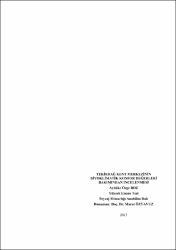| dc.contributor.author | BOZ, Aybüke Özge | |
| dc.date.accessioned | 2017-08-25T14:19:20Z | |
| dc.date.available | 2017-08-25T14:19:20Z | |
| dc.date.issued | 2017 | |
| dc.identifier.uri | https://hdl.handle.net/20.500.11776/2405 | |
| dc.description.abstract | Biyoklimatik konfor durumu; insanın en az miktarda enerji sarf ederek çevresine uyum sağladığı koŞullar olarak tanımlanmaktadır. Bir mekânda biyoklimatik konfor durumunun belirlenebilmesi için öncelikle sıcaklık, bağıl nem, radyasyon ve rüzgâr durumunun saptanması ve değerlendirilmesi gerekmektedir. Bu çalıŞmada Tekirdağ kent merkezinde rastgele seçim yöntemi ile 19 nokta belirlenmiŞ ve bu noktalarda her ayın bir günü sabah, öğlen ve akŞam olmak üzere sıcaklık, nem ve rüzgâr ölçümleri yapılmıŞtır. Elde edilen bu iklimsel veriler ile biyoklimatik konfor durumu analizi için ArcGIS 9.3 programı ve yöntem olarak da Ters Mesafe Ağırlıklı Enterpolasyon Tekniği (Inverse Distance Weighting – IDW) kullanılarak sıcaklık, nem ve rüzgar haritaları oluŞturulmuŞtur. Bu haritalar, belirlenen konfor değerlerine göre sınıflandırılarak çakıŞtırılmıŞlardır (overlay). ÇalıŞma sonucunda; Mart, Nisan, Eylül ve Ekim aylarının konfor bakımından en iyi aylar olduğu belirlenmiŞtir. Daha sonra ise biyoklimatik konfora sahip ayların ?ubat, Ağustos ve Eylül ayları olduğu görülmüŞtür. Ocak ve Temmuz aylarında ise çalıŞmada kullanılan biyoklimatik konfor değerlerine uygun sıcaklık değerleri bulunmadığından çakıŞtırma iŞlemi yapılamamıŞ ve biyoklimatik konfor bakımından uygun olmadığı tespit edilmiŞtir. | en_US |
| dc.description.abstract | Bioclimatic comfort situation means the most suitable conditions for human adaptation to environment in which the least energy is consumed. To determine the bioclimatic conditions of an area, we need to check temperature, relative humidity, radiation and wind conditions and evaluate this data. In this study we designated nineteen spots with random selection method and measured temperature, humidity and wind for all day in the morning, noon and evening. ArcGIS 9.3 software and Inverse Distance Weighting method was used for analysis of bioclimatic comfort situation with the climatic data that was collected and temperature, humidity and wind maps were generated. These maps were then categorized and overlayed according to comfort values that were determined. As a result of this work; March, April, September and October were identified as the best months for comfort. Then February, August and September were secondary months of comfort. January and July were not evaluated in this process because there were no suitable bioclimatic values in those months and they were identified as not suitable for bioclimatic comfort. | en_US |
| dc.language.iso | tur | en_US |
| dc.publisher | Namık Kemal Üniversitesi | en_US |
| dc.rights | info:eu-repo/semantics/openAccess | en_US |
| dc.subject | Biyoklimatik konfor | en_US |
| dc.subject | Coğrafi Bilgi Sistemleri | en_US |
| dc.subject | Ters Mesafe Ağırlıklı Enterpolasyon Tekniği | en_US |
| dc.subject | Çakıştırma | en_US |
| dc.subject | Bioclimatic comfort | en_US |
| dc.subject | Geographic Information Systems | en_US |
| dc.subject | IDW | en_US |
| dc.subject | Inverse Distance Weighting | en_US |
| dc.subject | Overlay | en_US |
| dc.title | TEKİRDAĞ KENT MERKEZİNİN BİYOKLİMATİK KONFOR DEĞERLERİ BAKIMINDAN İNCELENMESİ | en_US |
| dc.title.alternative | BIOCLIMATIC COMFORT VALUES ANALYSIS OF CITY CENTRAL OF TEKIRDAG | en_US |
| dc.type | masterThesis | en_US |
| dc.department | Enstitüler, Fen Bilimleri Enstitüsü, Peyzaj Mimarlığı Ana Bilim Dalı | en_US |
| dc.relation.publicationcategory | Tez | en_US |



















